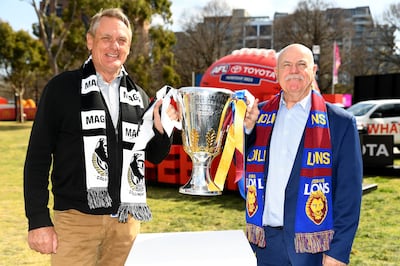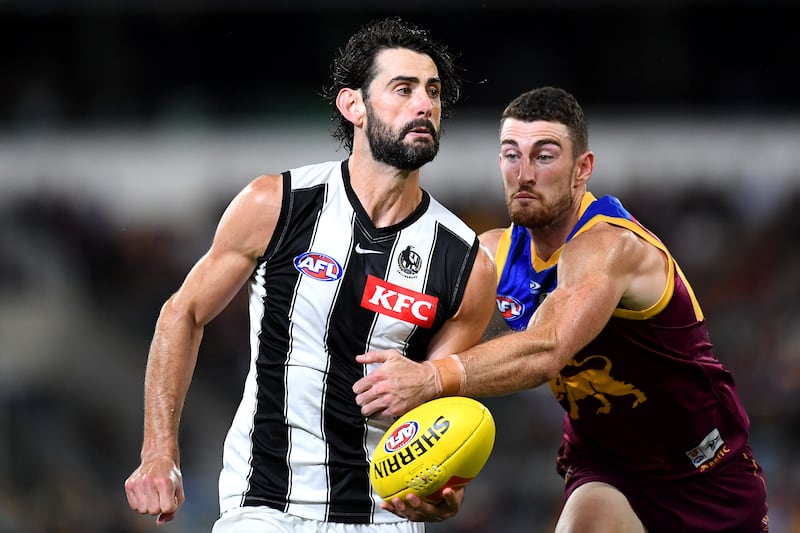Right-thinking sports lovers in Australia have been eagerly awaiting this coming Saturday.
Some would have spent Friday – a public holiday in the game’s honour in Melbourne – quietly contemplating the significance of the day and the deep-felt impact it will have on their lives.
Others might have used it for ironing, or shopping, ensuring all chores were out of the way for that “One Day in September” – the Australian Football League Grand Final.
This year, it’s the old foes who hailed from the northern suburbs, Fitzroy and Collingwood, at least as far as the Royboys' supporters in Melbourne are concerned.
One will celebrate until the start of the new year, while the other will collapse to the hallowed turf of the Melbourne Cricket Ground, sobbing uncontrollably to the repeated theme song of their rivals, and the bestial howls of the swilling hordes who sport their colours.
Fitzroy and its neighbours, the fiercely tribal Collingwood, were working-class, inner-city suburbs before the scourge of gentrification.
Although they shared a border, they were never close.
They became even more distant at the end of 1996, when a club merger resulted in eight Fitzroy players, with nary two coppers banging together in their pockets, moving to Brisbane, the capital of the northern state of Queensland.
The move was extremely unpopular, but was much to the delight of the Brisbane Bears’ players, as it meant they could replace the woeful logo of a fierce koala with the Royboys’ more noble lion.
(Any toddler in Australia could tell you that a koala is not a bear but a marsupial, and that their dopey demeanour from sitting all night munching on low-nutrient eucalyptus leaves can be pushed, at worst, to a little bit grumpy).
Regardless, on Saturday the proud Brisbane-Fitzroy Lions take to the field against the Collingwood Magpies at 8.30am UAE time.
This will mean little to lovers of other sports, particularly football. They fail to understand the excitement of watching 36 warriors at any time do battle on a field the size of a cattle station; why the ball is oval; and why the rules allow players to pick it up, as nature intended, with the hands we were so blessed to be given.
Most of all, they say they the rules are impossible to understand. Here, we will try to remedy that situation.

The Big Sticks
There are four posts at either end of the ground; two tall ones flanked by two smaller. The object of the game is to kick the ball, without it being touched by players of either team, between the two large posts. This results in a goal, which is equal to six points, or “behinds”.
If the ball touches the big pole, it is a behind. If it is kicked between a big and a small post, it is a behind. If it hits a small post, it is “out of bounds”. If it is kicked into the small post – or over the line anywhere on the outside of the field – without bouncing, it is “out on the full”, and the opposition receive a free kick.
If the ball is kicked or pushed between any of the posts by an opposition player, it is a “rushed” behind. If it is touched by a forward below the knee, it is a goal.
After a behind is kicked, one of the defenders, or backmen, kicks it back into play from the goal square. He does this unhindered.
After a goal, the ball is taken back to the centre square, where it is “balled up” by the umpire, and contested by infeasibly tall gentlemen called “rucks”, who try to thump it to the advantage of the smaller players at their feet.
The field of play
Eighteen players from each team take to the field at any given time. They are backed by an interchange bench of four men and a sub.
The four are generally rotated through the game. Each team has a maximum of 75 player interchanges in a match. Do try to keep count of them. It’s terribly important.
The sub comes on to replace a player who is not having a good day, is bleeding or is impaired in some other way during one of the less civilised passages of play. If he is subbed off, he cannot return.
The lines of position are full forward, half-forward, centre, half-back and full back. When the ball is bounced in the centre circle to start the game or after a goal, the six forwards must be inside the arc around their goals, the six backs in theirs, while four of the centremen from each team are allowed inside the centre square.
The wingmen, of which each team has two, are outside the square.
When the ball is bounced, all hell is allowed – and generally encouraged – to break loose.
The umpires
Umpires slam the ball into the ground to start play. They are trained to, but they aren’t always terribly suited to the purpose.
When the ball bounces awry due to its shape, sailing over the line of the centre circle, instead of making them do it again until they get it right, they are told to toss the ball up. Umpires must never be ridiculed.
There are now four of the dickens on the field, four more patrolling the boundaries, and two between the goals. Contrary to what you hear from most spectators, they largely come from good homes.
And they no longer have OPSM, the budget spectacles retailer, as their shirt sponsor, as once they did. Umpires must never be ridiculed.
Whenever a free kick or a mark – where a player catches the ball from either team before it hits the ground or is touched by another player – the umpire blows his or her whistle and shows the marker’s opponent where to stand, which is the spot where the mark was taken or the offence committed.
This is also called “the mark”. The opponent standing there is called “the man on the mark”. There he waves his arms in the hope of blocking the kick.
The umpires clearly warn the man on the mark to “Staaand” still. (Rumours that they would be instructed to add “Fingers on lips” have since been discredited. Umpires must never be … well, you get the point).
If a player fails to heed the order, or another player runs close to the man taking the free kick, the kicker will be moved 50 metres closer to his goals.
The penalty can also be inflicted if the ball is not quickly delivered to the kicker, or if a player ridicules the umpire.
Offences and indiscretions
Here’s where things can admittedly get a little muddy.
Apart from earlier mentioned offences, players can be awarded free kicks if their opponent:
• Runs more than 15 metres without bouncing the ball or touching it to the turf
• Incorrectly disposes of the ball when tackled. The ball must be kicked or handballed with a clenched fist while still sitting on the other hand
• Tackles the player beneath the knee or over the shoulders
• Slings the player to the ground in a tackle
• Tackles the player when they don’t have clean possession of the ball
• Pushes the player in the back
• Kicks the ball out of play intentionally, which is unfortunately up to the discretion of the umpire
• Interferes with the player’s arms when he is going for a mark, or
• Commits various forms of barbarism under the quaint category of “unduly rough play”
The umpire, of course, must see the offence before it can be called such.
To conclude
Hopefully by now you’re ready to observe with at least some knowledge the game in its purest form.
And while our cousins with the fragile shins and unemployed hands call their sport the “beautiful game”, and our stouter brethren describe their code as “the game played in heaven”, hopefully at 8.30 on Saturday morning you could consider watching “the game where umpires are respected, and the game we finally get”.






